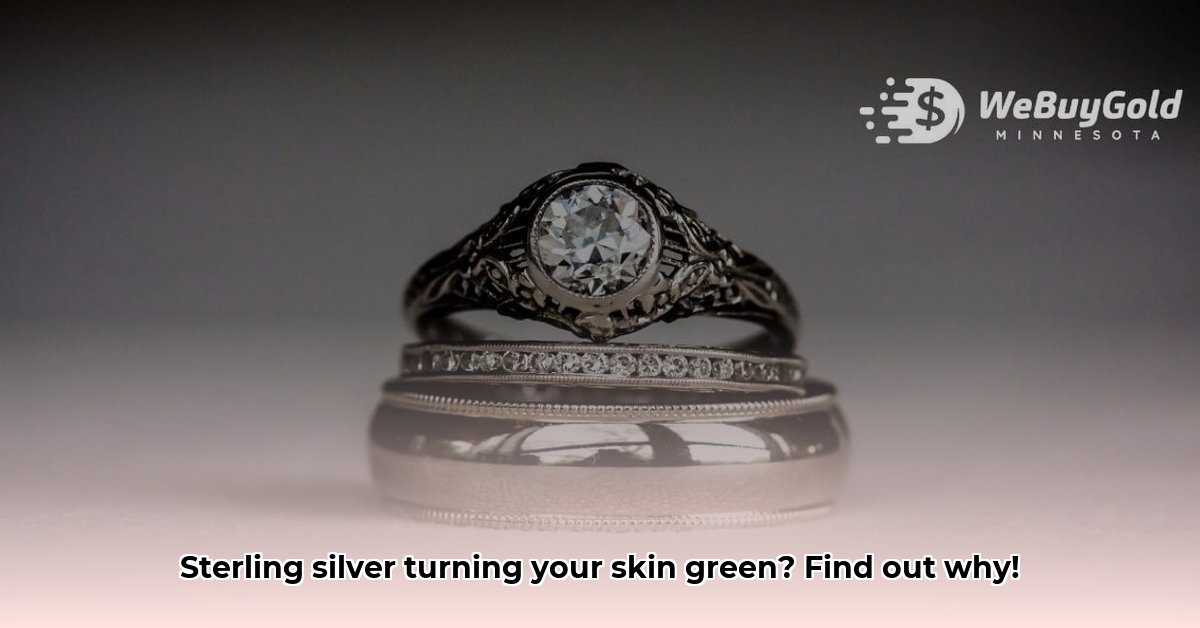Sterling silver jewelry is beautiful and affordable, but it sometimes leaves a greenish tint on your skin. Don’t worry, it’s not usually an allergy, just a common chemical reaction. This guide will explain the science behind the green discoloration, offer practical prevention tips, and suggest alternative metals if sterling silver just isn’t working for you.
The Science of Green Skin
That green mark isn’t an allergic reaction, but a simple chemical reaction. Sterling silver is an alloy, meaning it’s a mixture of metals. It’s typically 92.5% silver and 7.5% copper. That copper is the culprit behind the green discoloration. When copper comes into contact with the acids and moisture on your skin—especially when you sweat—it oxidizes. This reaction produces copper salts, which can then transfer to your skin, leaving that greenish tinge. Think of it like rust forming on iron, but green instead of reddish-brown. Lotions, perfumes, and even the air around you can also accelerate this process.
Preventing the Green
Here’s how to keep your silver shining and your skin stain-free:
-
Create a Barrier: Coating the parts of your jewelry that touch your skin with clear nail polish or a specialized jewelry sealant can help. Think of it like painting a wall – a layer of paint protects the wall underneath. These sealants create a barrier between the copper and your skin. Reapply periodically for best results.
-
Rhodium Plating: Consider buying rhodium-plated silver jewelry. Rhodium is a durable, tarnish-resistant metal that acts like a shield for your silver. It’s like giving your jewelry a suit of armor against discoloration.
-
Proper Storage: Store your silver in airtight bags or a jewelry box with anti-tarnish strips to minimize exposure to air and moisture, slowing down the tarnishing process.
-
Keep it Dry: Remove your silver before swimming, showering, or exercising to limit contact with moisture and chemicals.
-
Clean Regularly: Regularly cleaning your silver can help remove any copper salts before they have a chance to build up and stain your skin. A simple polishing cloth is often enough for light tarnish.
Exploring Other Metals
If sterling silver continues to cause discoloration, consider these alternatives:
| Metal | Discoloration Likelihood | Pros | Cons |
|---|---|---|---|
| Sterling Silver | Moderate | Affordable, classic look | Can discolor skin |
| Argentium Silver | Low | More tarnish-resistant than sterling silver, bright shine | More expensive than sterling silver |
| Fine Silver | Low | Purest form of silver, bright white | Softer, scratches easily |
| Gold (14k/18k/24k) | Very Low | Durable, various colors, hypoallergenic (typically) | Price increases with karat (purity) |
| Platinum | Very Low | Extremely durable, naturally hypoallergenic | Most expensive option |
| Titanium | Very Low | Lightweight, strong, hypoallergenic | More modern look |
| Palladium | Very Low | Similar properties to platinum, bright white luster | Expensive |
| Niobium | Very Low | Hypoallergenic, can be anodized for various colors | Less common, may be harder to find |
| 316L Stainless Steel | Very Low | Durable, affordable, hypoallergenic | Can sometimes contain nickel (an allergen for some) |
Cleaning Tarnished Silver
Even with precautions, tarnish can happen. Here’s how to clean your silver:
- Polishing Cloth: A polishing cloth designed for silver is often sufficient for light tarnish.
- Silver Cleaning Solution: For more stubborn tarnish, follow the product instructions carefully. Use a mild soap-and-water solution for routine cleaning. Dry thoroughly with a soft cloth.
- DIY Methods: Research DIY cleaning methods using household items like baking soda and aluminum foil. (Video tutorial coming soon!)
FAQ
- Is it an allergy? The green discoloration is likely a chemical reaction, not a true allergy. Allergies typically involve itching, redness, and swelling. Consult a dermatologist if you suspect an allergy.
- Where can I find hypoallergenic jewelry? Most jewelers carry hypoallergenic options, often made from platinum, titanium, niobium, or higher karat gold. Look for nickel-free stainless steel as a more affordable option.
- Does diet affect discoloration? Some research suggests a link between diet and skin pH, which could influence the reaction. While the connection isn’t fully understood, a balanced diet is always beneficial.
Conclusion
The occasional green tint from sterling silver is a common, harmless reaction. By understanding the cause, taking preventive measures, and knowing how to clean your jewelry, you can continue to enjoy its beauty. Remember, ongoing research continually refines our understanding of these reactions. If you’re concerned about any skin reaction, consult a doctor or dermatologist.
- Dora the Explorer Wipe-Off Fun: Safe & Mess-Free Activities for Little Explorers - April 18, 2025
- Does Lemongrass Repel Mosquitoes? Fact vs. Fiction + How to Use It - April 18, 2025
- Do Woodchucks Climb Trees?Fact vs. Fiction - April 18, 2025










